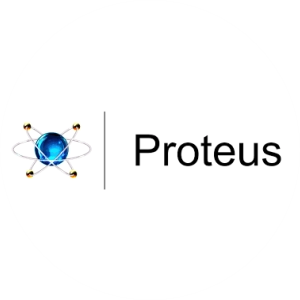
-
Proteus – Detailed Explanation
Proteus is a software suite used for electronic circuit design, simulation, and PCB layout. It is widely used by engineers, technicians, and educators for creating and testing electronic designs before physical prototyping.
1- On which platform are the tools used?
✅ Desktop Platforms:
- Windows (Most Common) – Compatible with Windows 7, 8, 10, and 11.
- Linux (With Wine) – Limited support, but works with Wine.
🚫 Not Available for:
- macOS (Directly) – Can be run using Windows emulation software like Parallels or Wine.
- Mobile Devices (No apps available)
💡 Proteus is primarily designed for Windows systems but can be used on Linux with Wine.
2- What hardware requirements are needed?
Proteus is a moderately demanding application.
🔹 Minimum System Requirements
- Processor: Dual Core 2.0 GHz or higher
- RAM: 2GB minimum (4GB or more recommended)
- Storage: 2GB of free disk space for installation
- Graphics: DirectX 9.0 compatible graphics card with at least 512MB memory
- Screen Resolution: 1366×768 or higher
- Operating System: Windows 7/8/10/11
💡 For complex simulations, higher RAM and processor speed are recommended.
3- Installation and membership stages
🔹 Installation Steps
- Download the installer:
- From the official website Labcenter Electronics.
- Run the installer:
- Follow the instructions to complete the installation.
- License Activation:
- For the free version (demo), just install and run.
- For the full version, purchase a license and enter the provided activation key.
🔹 Membership & Account Setup
✅ No registration required for demo version.
✅ Paid licenses available for more features:- Standard
- Advanced
- Professional
💡 Proteus requires a paid license for full functionality, especially for PCB design and advanced simulation features.
4- What can it be used for?
Proteus is used for designing, simulating, and testing electronic circuits and PCBs.
🔹 Primary Uses
✅ Circuit Simulation:
- Simulate analog, digital, and mixed-mode circuits.
- Includes simulation for microcontrollers (PIC, AVR, ARM, etc.).
✅ PCB Design:
- Design multi-layered PCBs with advanced routing features.
- 3D visualization of PCB designs.
✅ Microcontroller Programming:
- Supports various programming languages (C, Assembly, etc.).
- Testing microcontroller firmware before real-world implementation.
✅ Educational Purposes:
- Ideal for teaching electronics, embedded systems, and PCB design.
💡 Proteus is especially popular for microcontroller simulations, making it unique compared to general PCB software.
5- What is its prominent feature compared to other tools?
✅ Unique Features of Proteus
- Microcontroller Simulation: Simulate various microcontrollers (PIC, AVR, ARM, Arduino, etc.).
- Real-Time Debugging: Test firmware and interact with circuits during simulation.
- PCB Layout Design: From schematic capture to PCB design with 3D visualization.
- Component Library: Extensive library of components with customizable attributes.
- SPICE Simulation Engine: Accurate analog circuit simulation.
- Visual Designer for Arduino: Graphical programming environment for Arduino projects.
💡 Unlike tools like Tinkercad, Proteus allows detailed microcontroller simulation and PCB layout creation.
6- Sample application made with pictures
Example 1: Microcontroller Simulation Interface
Circuit Simulation with Arduino and Various Components
Example 2: PCB Layout Design
Creating and Visualizing PCB Designs
💡 Proteus provides a complete design workflow from circuit design to PCB layout.
7- Which courses can it be used in and is compatible with?
Proteus is compatible with courses related to electronics, embedded systems, and engineering design.
🔹 Relevant Courses:
- Electrical Engineering – Circuit design and testing.
- Electronics & Microcontroller Programming – PIC, AVR, ARM, Arduino projects.
- Computer Science – Embedded systems design and testing.
- Mechatronics & Robotics – Designing and simulating control systems.
- Physics & Engineering Labs – Simulation of analog and digital circuits.
- Technical Drawing & PCB Design – From schematic capture to PCB production.
💡 Proteus is highly suitable for vocational training in Electrical Engineering, Electronics, and Mechatronics.
8- Is it free?
🚫 No, Proteus is not free, but it offers a limited-feature demo version.
🔹 Free vs Paid Versions
Feature
Demo Version
Paid Version
Circuit Simulation
✅ Basic (Limited)
✅ Full (All Components)
Microcontroller Support
❌ No
✅ Yes
PCB Layout Design
❌ No
✅ Yes
3D Visualization
❌ No
✅ Yes
License Type
Free (Demo)
Standard, Advanced, Professional
Price Range
Free (Demo)
Varies (Starting from $200)
💡 The free version is only for evaluation purposes and has limited features.
9- Links related to Proteus
🔗 Official Website: Labcenter Electronics
🔗 Download Page: Proteus Downloads
🔗 Documentation & Tutorials: Labcenter Support
🔗 Proteus Forum (Support & Discussions): Proteus Forum🔹 Conclusion
Proteus is an excellent tool for circuit design, microcontroller simulation, and PCB layout. It is especially useful for vocational education in Electrical Engineering, Electronics, and Mechatronics.
🚀 Why use Proteus?
✔ Advanced Simulation Capabilities – Microcontroller simulation with real-time debugging.
✔ Comprehensive PCB Design Tools – From schematics to 3D visualization.
✔ Educational Application – Highly useful for teaching embedded systems and electronics.
✔ Extensive Component Library – Includes various microcontrollers and electronic components.